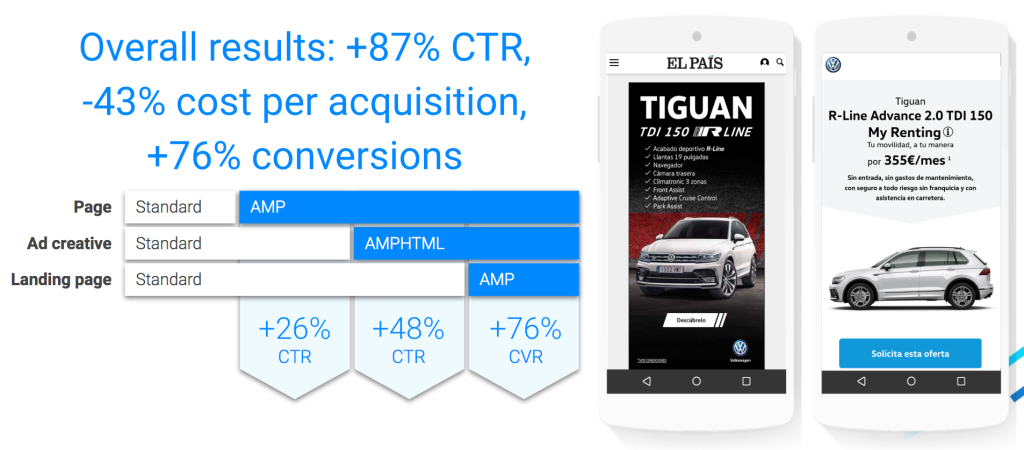
Volkswagen, one of the world’s largest automotive companies, sought to improve the user experience of potential customers for their 2019 Tiguan TDI 150 R Line. Given their business goals and desire to test the state-of-the-art in speed and performance, they decided to test AMP technology for both their landing page, and the ad creatives that would drive users there.
EL PAÍS, a company within the Prisa Group, is the world’s leading Spanish-language news medium, in its digital format. It has 64.7 million unique users per month worldwide. Digital transformation is key to Prisa’s business, and they maintain a position at the forefront of digital innovation.
EL PAÍS was an early adopter of AMP technology, launching their first AMP version of EL PAÍS in 2015. They have been using this technology since then, to serve fast high-quality content to their large audience on mobile. Similarly, EL PAÍS was one of the first adopters globally of AMPHTML ads (ad creatives built with AMP).
Objective
Many news and entertainment publishers already use AMP to deliver beautiful, fast pages to end users across devices. However, the creatives that serve to these pages are typically built with standard HTML, which tend to result in degraded performance and therefore lower ROI for advertisers.
Volkswagen and EL PAÍS, together with the creative agency DDB, media agency PHD, and with the support of Google, have conducted a test to evaluate the benefits of AMPHTML ads.
The Test
EL PAÍS conducted the experiment by configuring four different line items in their ad server, featuring a 2×2 combination of environment (AMP vs. non-AMP) and creative type (AMPHTML vs. HTML). This allowed them to compare the performance characteristics of the AMPHTML creative and its original HTML equivalent, both in an AMP environment and within traditional mobile Web. Additionally, they tested two flavors of landing pages (HTML and AMP), allowing for a full comparison of results throughout the conversion funnel.
Results
After collecting data from more than 2M impressions on mobile devices, AMP technology has shown strong performance increases relative to standard HTML:
- AMP pages and ads versus standard HTML pages and ads
- +87% CTR
- +36% viewability rate
- +81% visits to landing page
- AMP Landing Page relative to standard HTML Landing Page
- +76% conversion rate
- -43% cost per acquisition
Simply moving from a standard HTML page to an AMP page (with the same standard HTML ad) resulted in a 26% CTR increase. Moving further to an AMP page with an AMPHTML ad resulted in an additional 48% CTR increase.
The AMP page also add an extra +76% Cvr versus the standard HTML page.
Conclusions
Prisa’s test demonstrated that AMP’s superior performance characteristics can deliver meaningful ROI benefits to advertisers. Improved viewability and conversion rates result in lower user acquisition costs, and the benefit is multiplied when AMP pages and AMPHTML ads are deployed together. And not only does AMP provide positive ROI for publishers and advertisers, it does it while improving the end user experience, yielding a more sustainable web for everyone.
Posted by Pilar Sanchez, Mobile Specialist, Google